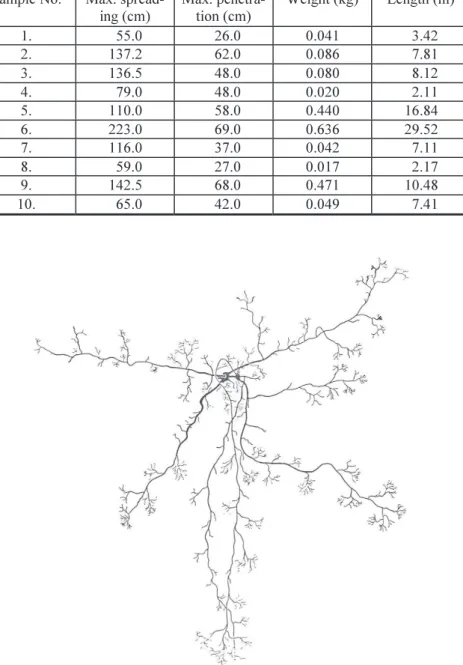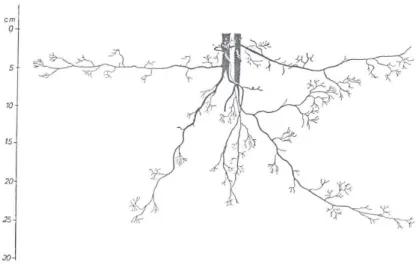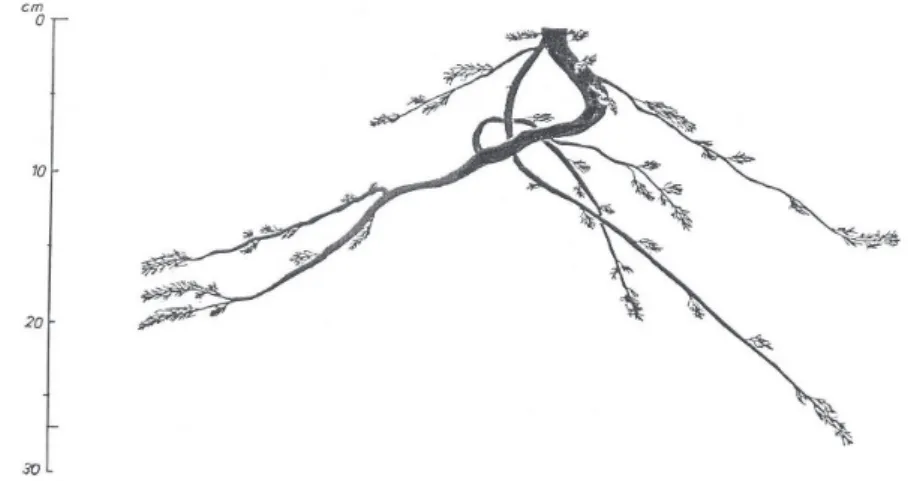Root - system of Crataegus monogyna L. in oak forest of Síkfőkút
*Imre Kárász
Department of Enviromental Science
Introduction
As a part of comprehensive synbiological studies in forest at Síkfőkút the root level of the association has been scrutinized since 1979. Throughout the studies roots of several shrub species have been revealed (e.g. Kárász- Juhar 1982, Kárász 1984, 1984 a, 1984 b., 1986, 1991). In this report results concerning the physiognomy of root-system of the permanent member of the forest’s shrub level, the hawthorn (Crataegus monogyna) are summarized.
Material and method
Crataegus monogyna is a European flora element, a shrub of both low- lands and mountains growing up occasionally to trees of minor scale. Eco- logical index numbers of this species are as follows: T:5, W:4, R:3, N:2. It belongs to eco-group No. 47. (Geum urbanum, Zólyomi et. al., 1966, Soó 1966, Csapody et al., 1966). It tolerates disturbing factors well (Z:2, Simon 1992). In Europe it might be regarded as one of the most widely spread spe- cies. It plays a decisive role in the shrubs of the lowland plains (Pruro spino- sae-Crataegetum, Crataegeo-Cerasetum fruticosae), produces considerable entity numbers in dwarf almond forests (Amygdaletum nanae), in rock shrubs (Cotoneastro-Amelanchieretum) and in secondary associations, forest associations subsequent to clearing. Its wide range ecological tolerance makes it possible to be present as accompanying species in bush forests of mountains and hills as well as in oak and beech woods. It can be considered to be a predominant species in forest-edges and field protecting hedgerows.
Its habitat is restricted, tolerates well even immoderate climate. It is of no sylvicultural significance (Csapody et al., 1966).
* Int. Conference „25 Years Síkfőkút Project Jubilee”, Noszvaj, 25-27 Mai, 1998 (Hungary)
Its occurrence is sporadic in the turkey oak-oak forest at Síkfőkút at the shrub level. It takes as an average some 1,8% of all shrubs per ha. According to the estimation in 1988 decisive majority of the 1615 entities pro ha. be- longed to the type of small-shrubs, as it is called, just 187 entities exceeded the 1 m height limit (Kárász-Antal 1998).
The soil of the forest at Síkfőkút is a significantly acidified version (pH=5,3-5,9) of the clay-containing brown wood soil. In the past few years the pH value has been reduced to some extent.
Throughout the investigations the root structure of 10 thorn-bushes of different ages has been revealed by means of gradual grubbing method.
When revealing horizontal and vertical rhyzogram has been taken of the roots, on which each root-item of over 1 mm diameter has been indicated.
The data regarding the sample shrubs are summarized in Table 1..
Acknowlegement: At this place I render thanks to Csilla Csépányi for the valuable assistance in revealing the shrubs and preparing the drawings.
Results
The young roots of the Crataegus monogyna are white or ivory-white, turning ash-grey at the end of the first year, later darker brownish grey. In raw condition they are flexible, subsequent to drying they tend to break in a splintery manner.The results of root measurements of the sample shrubs are shown in Table 2. The structure of root-junctions is demonstrated in Figures 1 to 8.
Its root-system is typically a tap-root system. It is obvious in case of the revealed 10 entities that well developed tap-root is formed growing with little bend, curvatures in vertical direction till total attenuation. The sample shrub number VIII. is the only exception, whose major root section bent away even 10 cm under the surface and did not turn vertical later. The bend was caused by the root of a Quercus petraea growing under the sample shrub.
The major root has got a few junctions of 5-8 mm of diameter, at differrent levels in terms of depth and parallel with the ground level. On these items and on the major root as well numerous brush-like, secondary and tertiary root branches might be observed. On each root-brush rather huge number (60-150 pieces) of soaking root-end could be found. At the region of the collar a root-wreath of 20-60 cm of diameter is formed by the roots whose diameter is equal to or thinner than 1 mm. Presumably it plays an important role in up-taking and utilizing precipitation flowing down the root- stock. A secondary root is frequently originated from the collar, which is
thinner than the tap-root (4-8 mm of diameter), it runs obliquely and penetrates deeper than the tap-root (samples number I., III. and VIII.).
The roots ensnare the soil in a loose way. Their horizontal expansion is similar to that of the foliage. As far as their vertical dimension is concerned, it ranges from 26 to 69 cm in cases of the studied entities.
Faragó excavated (1961) the root system of older (24,-41,-51-and 54- year–old) specimens growing on sandy soil. According to his observations the hawthorn owns a well developed tap-root, and in sandy-soil short of wa- ter-supplies the tap-root usually reaches the level of the ground-water. How- ever its water requirement is primarily satisfied by the side-roots growing in the upper soil layer of 40 cm depth.
Tillers are not formed, but occasionally one root structure may com- prise two shoots above the soil of similar ages and level of development (samples No. III. and V.).
The Crataegus monogyna might be classified into the plants with fin- ger-like tap-root capable of secondary thickening in the system of Krasil- nikov (1968) (group 1., subgroup 1., type 3.).
Table 1: Data of Crataegus monogyna sample shrubs regarding size, age and habitat.
Sample number
Root-stock diameter
(mm)
Height (cm)
Cover
(m2) Age (year) Habitat
1. 8.0 90.0 0.16 6 20% shadowing among
intermediately clump shrubs
2. 13.7 135.0 0.38 12 25%-os shadowing (7), on a
slope of 200
3. 9.1-6.7 102.0 0.14 6 75% shadowing, among clump shrubs
4. 13.5 147.0 0.97 11 not shadowed
5. 8.6-8.2 121.0 0.41 7
100% double shadowing, among intermediately clump shrubs
6. 27.6 214.0 1.52 17 10% shadowing among
sparse shrubs
7. 6.4 85.0 0.13 5 100% shadowing, among
clump shrubs
8. 9.0 34.0 0.11 7 15% shadowing among
intermediately clump shrubs
9. 17.1 172.0 1.95 14
on a slope of 20O , 40%
shadowing among interme- diately clump shrubs 10. 13.1 75.0 0.68 11 not shadowed, among sparse
shrubs
Table 2: Max. spreading and penetration of the roots of the sample shrubs Crataegus monogyna and weight as well as length of roots thicker than 1 mm.
Sample No. Max. spread- ing (cm)
Max. penetra- tion (cm)
Weight (kg) Length (m)
1. 55.0 26.0 0.041 3.42
2. 137.2 62.0 0.086 7.81
3. 136.5 48.0 0.080 8.12
4. 79.0 48.0 0.020 2.11
5. 110.0 58.0 0.440 16.84
6. 223.0 69.0 0.636 29.52
7. 116.0 37.0 0.042 7.11
8. 59.0 27.0 0.017 2.17
9. 142.5 68.0 0.471 10.48
10. 65.0 42.0 0.049 7.41
Fig. 1. Horizontal aspect of the root system of Crataegus monogyna (1st sample).
Fig. 2. Vertical aspect of the root system of Crataegus monogyna (1st sample).
Fig. 3. Horizontal aspect of the root system of Crataegus monogyna (3rd sample).
Fig. 4. Vertical aspect of the root system of Crataegus monogyna (3rd sample).
Fig. 5. Horizontal aspect of the root system of Crataegus monogyna (5th sample).
Fig. 6. Vertical aspect of the root system of Crataegus monogyna (th sample).
Fig. 7. Horizontal aspect of the root system of Crataegus monogyna (8th sample).
Fig. 8. Vertical aspect of the root system of Crataegus monogyna (8th sample).
References
Csapody I.–Csapody V.–Rott F. (1966): Erdei fák és cserjék. (Forest-trees and shrubs), OEE, Budapest, 152–153.
Csépányi Cs. (1983): A Crataegus monoyna és az Acer tataricum gyökérrendszere.
(The root-system of Crataegus monogyna and Acer tataricum), Szakdolgo- zat (mscr.)
Faragó S. (1961): A homoki cserjék gyökérfeltárása. (Revealing of the roots of shrubs growing in sandy-soil). Erd. Kut. 1–3. 341–360.
Kárász I. (1984): Az Acer campestre L. gyökérrendszerének szerkezete a síkfőkúti cseres-tölgyesben. (Structure of root-system of Acer campestre L. in the turkey oak-oak forest at Síkfőkút). Bot. Közlem. 71: 79–100.
Kárász I. (1984 a): Adatok a Cornus sanguinea L. gyökérzetének fiziognómiai struktúrájához. (Data regarding physiognomical structure of the roots of Cornus sanguinea L.) Acta Acad. Paed. Agriensis. NS. XXVII. 739–753.
Kárász I. (1984 b): Egy mérsékelt övi tölgyes cserjefajainak gyökérzete. (The root- system of the schrubs species in an oak forest). Kandidátusi értekezés, Eger.
Kárász I. (1986): Gyökérvizsgálatok Magyarországon (Root studies in Hungary).
Bot. Közlem., 73: 19–24.
Kárász I. (1991): Tölgyes cserjefajok gyökér-hajtás aránya. (Root-shoot proportion of shrub species in oak forest). Acta Acad. Paed. Agriensis NS. XX.: 132–
138.
Kárász I.–Juhar E. (1982): A Cornus mas L. gyökérzetének fiziognómiai struktúrája a síkfőkúti tölgyesben. (Physiognomical structure of the roots of Cornus mas L. in the oak forest at Síkfőkút ). Bot. Közlem. 69: 105–130.
Kárász I.–Antal Cs. (1998): A síkfőkúti tölgyes cserjeszintjének struktúra adatai 1988-ban. (Structural data on the shrub level in the oak forest at Síkfőkút in 1988). Acta Acad. Paed. Agriensis. (mscr.)
Krasilnikov, P. K. (1968): On the classification of the root system of trees and shrubs. In: N. S. Ghilarov (ed.): Methods of productivity studies in root system and rhyzosphere organisms. Nauka, Leningrad. 106–114.
Simon T. (1992): A magyarországi edényes flóra határozója. Harasztok, virágos növények. (Identificating book of vascular flora of Hungary). Tankönyvki- adó, Budapest.
Soó R. (1966): A magyar flóra és vegetáció rendszertani-növényföldrajzi kézikönyve II. (Phytogeographical and taxonomical handbook II. of the hungarian flora and vegetation). Akadémiai Kiadó, Budapest, 412–413.
Stefanovits P. (1985): Soil conditions of the forest. In: Jakucs P. (ed.): Ecology of an oak forest in Hungary. Results of Síkfőkút Project I. Akadémiai Kiadó, Bu- dapest.
Zólyomi B. (1966): Einreihung von 1400 Arten der ungarischen Flora in ökologische Gruppen nach TWR-Zahlen. Fragmenta Botanica, IV.: 101–142.





